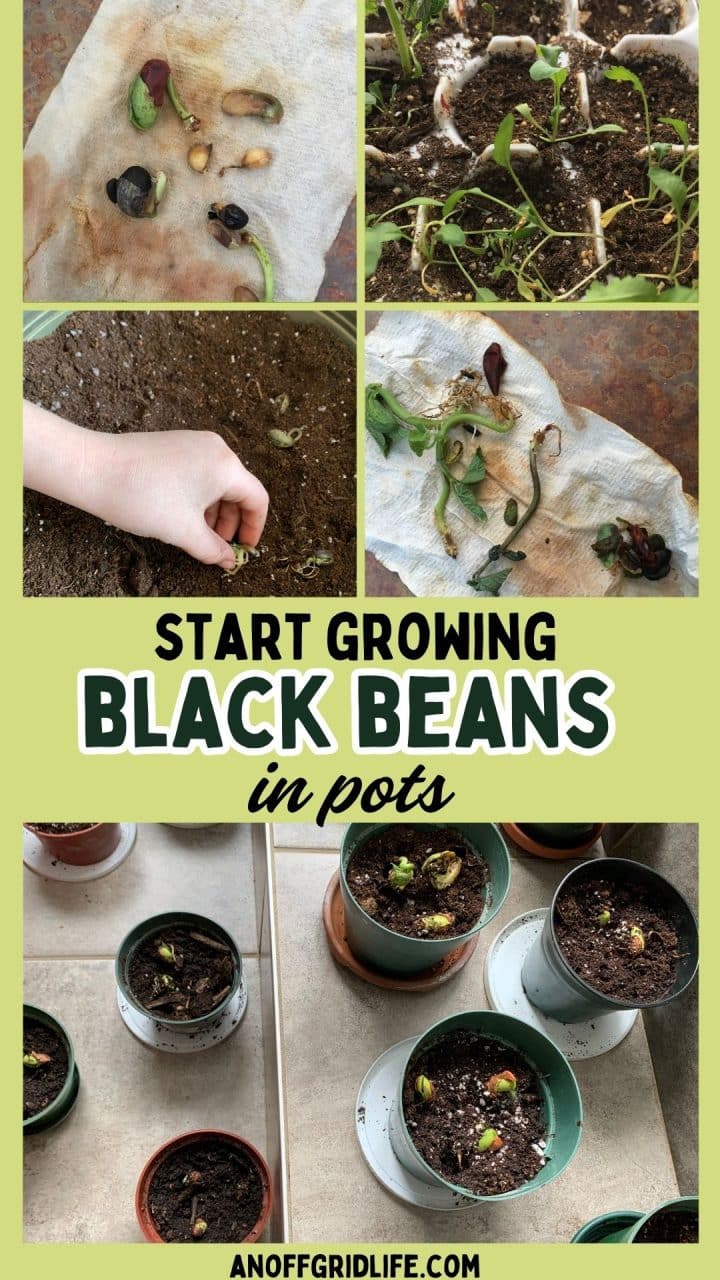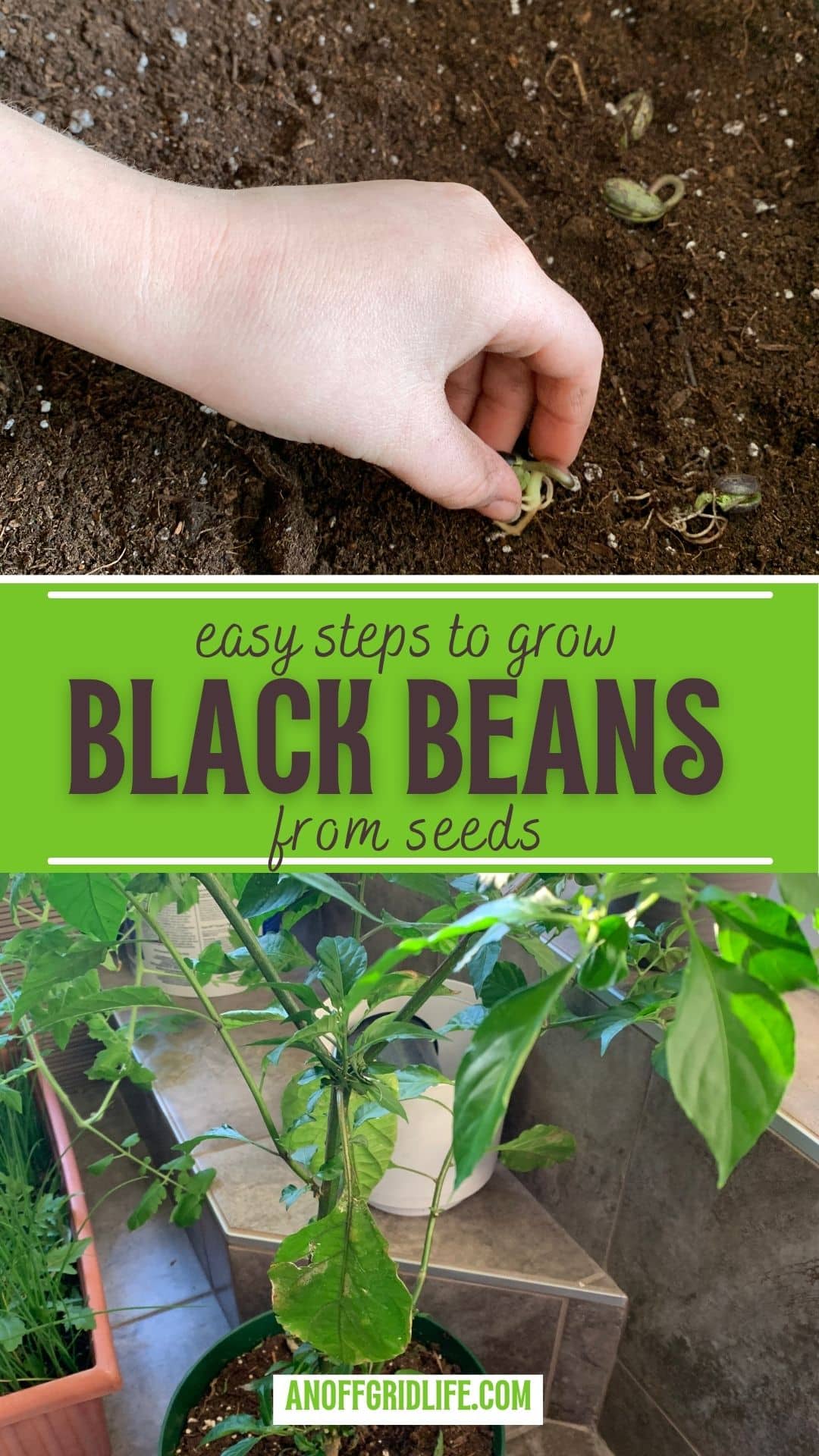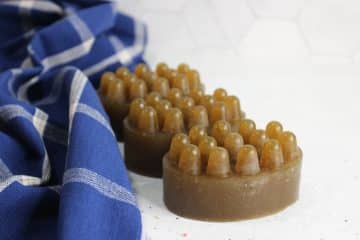A couple of years ago, we sprouted dried red kidney beans as a homeschool experiment. It was the middle of winter in northern Canada, yet not only did they sprout, but they also produced more kidney beans. The kids were amazed. By following the instructions that came with our Sonlight homeschool curriculum kit, they had produced food! It wasn’t long before they wanted to learn how to grow black beans indoors as well. Here’s how we did it - and how you can too.
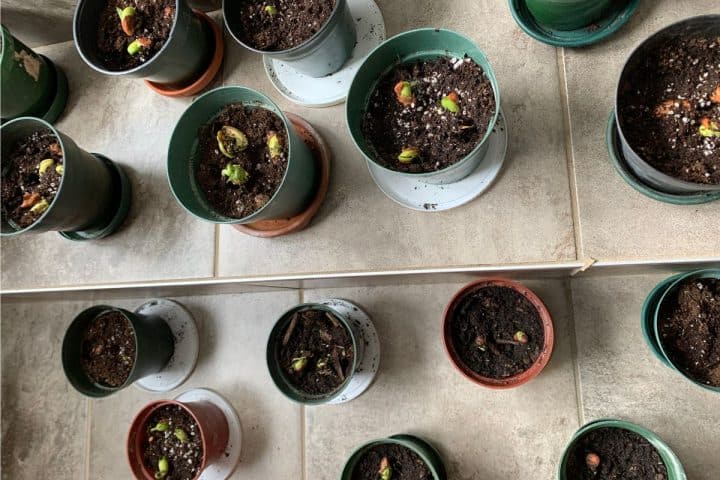
Jump to:
- Why Learn How to Grow Black Beans Indoors
- How I Use Black Beans in Our Off Grid Kitchen
- Soaking Dried Black Beans Before Cooking
- Why I Freeze My Cooked Dried Beans
- How Many Dried Beans Do We Eat in a Year?
- How Many Black Beans To Grow?
- Where to Get Dried Black Beans for Sprouting
- What You’ll Need to Grow Black Beans Indoors
- How to Grow Black Beans in a Mason Jar
- Grow Black Beans Any Time Of Year
- The Right Conditions for Black Bean Growth
- Our Bathroom Beanery
- Transplanting Our Bean Plants
- Our Great Northern Bean Experiment
Why Learn How to Grow Black Beans Indoors
As a family homeschooling off the grid in Canada’s Northwest Territories, the high price of food, shipping, and northern food security is nothing new. For over eleven years we played at wilderness living, bushcraft, foraging, small game hunting, fishing, and off-grid homesteading.
However, recent world events have made us much more serious about securing our food supply through activities like learning how to scale up our gardening efforts and grow more black beans to feed our family.
Five years ago, we got 20 Western Rustic, dual-purpose chickens bred for cold climates. We also added 10 Barred Rock chickens, which are layers, to keep us in eggs. One day, we'll start learning how to raise meat rabbits as well.
How I Use Black Beans in Our Off Grid Kitchen
Before learning how to grow black beans, think about how you’ll use them in your own household.
As a mother, I’ve always been concerned about the quality of protein I’m feeding my kids. And while all of our kids are huge steak fans, they also all like bean-based dishes like three bean chili, rice and beans, black bean and ham soup, and a family favorite, my Chicken Black Bean Salsa Casserole dish.
Recently I started making this incredible sweet potato black bean soup too. So good.
I use black beans in baking. Black Bean Brownies are really good. I also use them in soup, stews, casseroles, and even in summer salads.
Soaking Dried Black Beans Before Cooking
Using dried beans for cooking and baking requires planning because they need to be soaked. Now I try to stick to a meal plan to create meals from leftovers. So each evening, I can take a quick look at my plan and see what needs prepping.
Now that our older kids are grown, I usually cook for four through the winter. So I might only soak two cups of dried beans in four cups of water overnight. I add a quarter onion, diced, one garlic clove, and maybe a sprinkling of salt.
Why I Freeze My Cooked Dried Beans
In the summer, when we have lots of visitors, I often cook for eight to twelve or more people. And I don’t like to simmer beans any longer than I have to because the five-burner propane cooktop generates a ton of heat.
This past week I soaked 5 cups of dried mixed beans in 12 cups of water overnight. This produced 11 cups of beans. I used five for my Big Batch Mixed Bean Chili (recipe will get posted this weekend.)
And I froze the rest in portions. 1 3-cup portion, 1 2-cup portion, and 1 1-cup portion.
How Many Dried Beans Do We Eat in a Year?
Our homestead kitchen pantry usually holds at least three to four bags of the President’s Choice Blue Menu: dried black beans, dried red kidney beans, and dried small chili beans. And then during the pandemic, we began to experience food and also toilet paper shortages at the grocery store.
So I made a plan to become more self-reliant about our family’s food supply. I went through my pantry with a fine-tooth comb, which I hadn't done since our last pantry challenge. And I remembered how to grow black beans indoors from our previous homeschool science activity.
I also know that dried beans, lentils, and other legumes last a really, really long time. I suspect years.
How Many Black Beans To Grow?
Next, I needed to figure out how much to plant to feed my family.
According to my calculations, my family goes through about one hundred and thirty cups of dried beans annually on average.
This means we need at least sixty-five dried bean plants. And twenty of those were black bean plants. This is one of those times where I’d rather err on the side of caution and overplant. And as you’ll find out, it was a good thing I did.
Where to Get Dried Black Beans for Sprouting
You can probably get dried black beans for sprouting from an online seed company or even Amazon. But you know what? I didn’t.
I just grabbed a handful of dried black beans from my stash in the pantry. And they all grew just fine.
What You’ll Need to Grow Black Beans Indoors
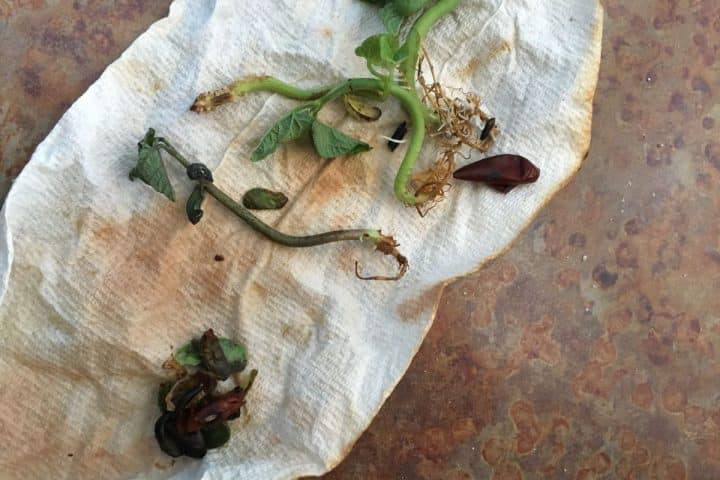
If you’re wondering how to grow black beans without a whole lot of gardening gear, don’t. Your supply list is very short.
Here’s what you’ll need:
- Dried black beans
- Paper towel
- Water
- Glass jar
How to Grow Black Beans in a Mason Jar
- Arrange your supplies on a clean kitchen counter or table.
- Soak a piece of paper towel in room-temperature water.
- Place evenly spaced three to five black beans on the damp paper towel.
- Fold the paper towel over the beans so they’re in between two layers of damp paper towel.
- Line a clean glass mason jar or another glass jar with a paper towel. If the beans fall to the bottom of the glass, carefully move them back up between the layers.
- Set your glass in a sunny windowsill.
- You should see sprouts within a week to ten days.
Grow Black Beans Any Time Of Year
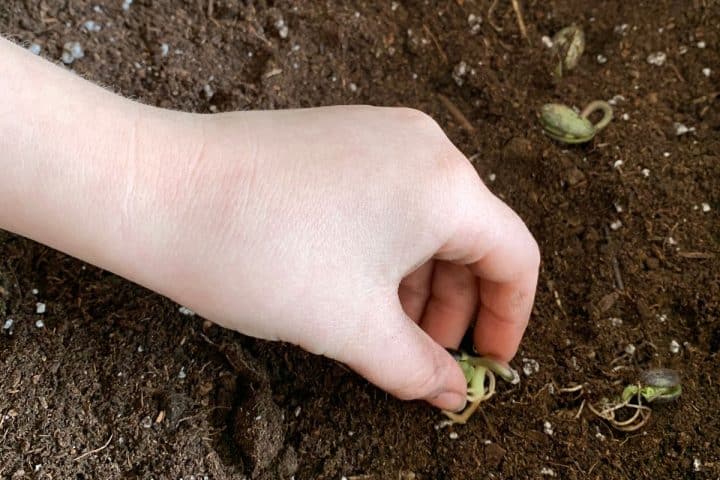
Using the “sprout black beans in a mason jar” method means you can grow beans any time of the year. While the idea was to sprout and then transplant, I forgot one year.
My then-four-year-old, however, was a more attentive gardener than I was. She diligently kept an eye on her bean jar. She was determined that her beans would grow better than her seven-year-old sister’s. And so she made sure that the beans were warm and the paper towel was moist.
Well, that bean sprouted. And it grew. And it grew some more. Then, all of a sudden, it was about five inches tall when I noticed bean pods on it. And within those pods? You guessed it. More black beans.
The Right Conditions for Black Bean Growth
I wasn’t sure that black beans - or any other kind of dried beans- would grow this far north. They need hot, moist conditions to sprout. And then hot, dry conditions to grow.
Our kitchen window faces south, and even in the winter, we’ll get a few hours of daylight on that windowsill. Yet, there isn’t enough space there for the number of bean plants I was attempting to grow this year.
Our Bathroom Beanery
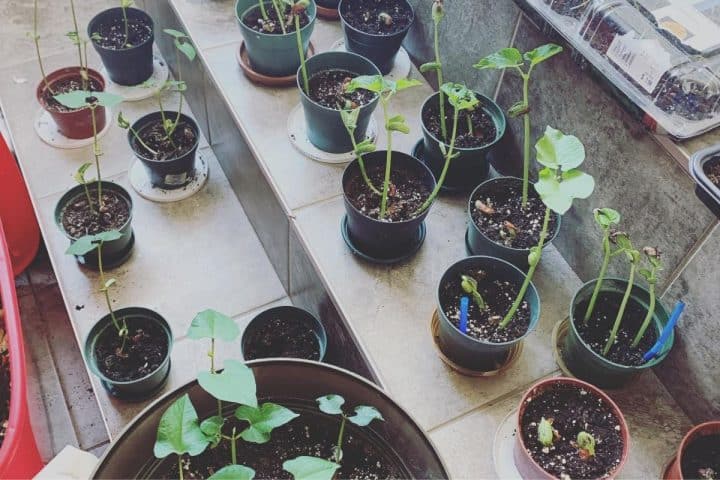
This year, we started our beans in our downstairs washroom/laundry room. It has both a south-facing window and a north-western-facing window. And according to my records, this year we planted 65 dried beans indoors on March 22nd, and they started sprouting on March 30.
They included red kidney beans, black beans, chili beans, and four heritage specialty beans from my friend Rochelle Robinson, a homesteader down in Saskatchewan.
Transplanting Our Bean Plants
And those beans took off. They grew like crazy, even outstripping the tomatoes growing nicely alongside them. Once our beanstalks reached about two inches high and had a couple of leaves each, it was transplanting time.
I transplanted them into pots, four beans to a pot, so about 15 bean pots in total. I arranged them around our bathtub so they’d get maximum light. It’s moist and warm because of our propane off the grid washing machine and dryer.
Our Great Northern Bean Experiment
This year is a big experimental year for us in several areas, including the garden. Gardening in our northern climate challenges us to think outside the box.
We get over 20 hours of sunlight and hot weather in the summer months (it is 30 degrees Celsius or 86 Fahrenheit today)and just about four hours of daylight and routine temperatures of -30 Celsius and colder in the winter. So, although we get seeds from down south, the planting guidelines on the back of the envelopes don’t help me much. With cold frames and indoor gardening, we make it work.
I had to figure out where these beans would do best. So I split them up.
I planted twelve bean plants directly into our raised garden bed on the east side of the house during the second week of June. It was still too cold - they all died. (The squash plants at their bases are growing strong, though.)
I planted three bean plants directly into our south-facing garden bed that same week. They also all died within the week.
I planted four sprouted beans into a large pot and put them in our dining table. It’s quite pretty and has recently produced a few pods of black beans.
The remaining 46 bean plants (remember, I had 65 total) are all housed in our glassed-in wraparound deck. They’re hanging out in the northwest corner and thriving in pots of various sizes. However, I doubt they’ll produce enough to keep us in beans for a year.
Next year’s project will be how to improve my soil with organic fertilizer to get those bean plants to produce more.
Which vegetables do you grow indoors? Got any bean-growing tips for me? Let me know by commenting below.
Like this post? Save it to your favorite Pinterest board for later



